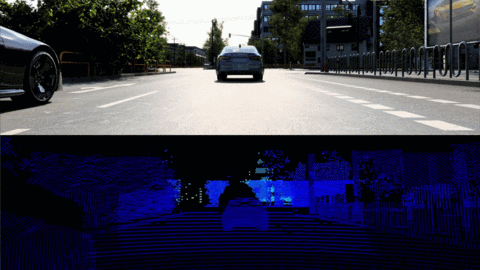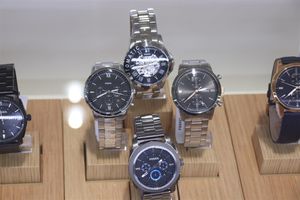AEye Introduces Industry's First Adaptive Lidar Simulation Suite on NVIDIA DRIVE Sim
AV & ADAS Developers Can Now Use the NVIDIA DRIVE Sim Platform to Optimize Lidar Sensors for Specific Use Cases and Vehicle Types
AEye, Inc. (NASDAQ: LIDR), a global leader in adaptive, high-performance lidar solutions, today announced that Continental’s HRL131 Long Range Lidar, based on AEye’s patented architecture, is now available for testing and development on the NVIDIA DRIVE Sim™ platform. As NVIDIA announced today, Continental and AEye, will utilize the NVIDIA DRIVE Sim platform to enable AV and ADAS customers to rapidly simulate a fully adaptive lidar system in a variety of autonomous driving edge cases and environments. This saves OEMs time during development and testing, accelerating time-to-market for commercial deployment.
This press release features multimedia. View the full release here: https://www.businesswire.com/news/home/20220922005723/en/

(Graphic: Business Wire)
“The software-defined nature of the HRL131 means it is situationally aware, with the ability to adapt its scan pattern depending on the driving scenario to maximize safety,” said Jordan Greene, GM of Automotive at AEye. “It’s critical that manufacturers be able to test and validate these performance modes and the product’s performance in diverse situations, which NVIDIA DRIVE Sim will uniquely enable.”
The adaptive nature of Continental’s HRL131 Long Range Lidar is capable of deploying multiple scan patterns, including different fields of view (FOV), for disparate driving conditions and use cases. By integrating with NVIDIA DRIVE Sim, developers gain the ability to simulate the performance of different scan patterns in order to define and optimize each, and further refine the performance of the HRL131 to match their specific requirements.
This is especially important for high-speed highway driving, where even a small object can make a big impact. NVIDIA DRIVE Sim allows the recreation of obstacles in many shapes and sizes, with accurate physical based rendering, in complex highway environments. With a digital twin of the HRL131, and various environments and differing conditions of its usage in NVIDIA DRIVE Sim, OEMs and AV developers can determine which performance modes are more suitable for the chosen application based on solving for complex edge cases. Once identified and tuned, performance modes can be swapped on-the-fly using external cues such as speed, location or vehicle pitch.
“With the scalability and accuracy of NVIDIA DRIVE Sim, we’re able to validate our long-range lidar technology efficiently," said Gunnar Juergens, Head of Product Line LiDAR at Continental. It’s a robust tool for the industry to train, test and validate safe self-driving solutions.”
Continental developed the HRL131 in partnership with AEye, who licensed its 4Sight Intelligent Sensing Platform, reference architecture, and software to Continental to provide the basis for the product. The long range lidar offers maximum leverage for passenger vehicle applications, because it combines a high dynamic spatial resolution with long range detection. With the HRL 131, vehicles can be detected at more than 300 meters, and pedestrians at more than 200 meters. Continental is integrating the long range lidar technology into its full sensor stack solution to create the first full stack automotive-grade system for Level 2+ up to Level 4 automated and autonomous driving applications.
About AEye
AEye’s unique software-defined lidar solution enables advanced driver-assistance, vehicle autonomy, smart infrastructure, logistics and off-highway applications that save lives and propel the future of transportation and mobility. AEye’s 4Sight™ Intelligent Sensing Platform, with its adaptive sensor-based operating system, focuses on what matters most: delivering faster, more accurate, and reliable information. AEye’s 4Sight™ products, built on this platform, are ideal for dynamic applications which require precise measurement imaging to ensure safety and performance. AEye has a global presence through its offices in Germany, Japan, Korea and the United States.
Forward-Looking Statement
Certain statements included in this press release that are not historical facts are forward-looking statements within the meaning of the federal securities laws, including the safe harbor provisions under the United States Private Securities Litigation Reform Act of 1995. Forward-looking statements are sometimes accompanied by words such as “believe,” “continue,” “project,” “expect,” “anticipate,” “estimate,” “intend,” “strategy,” “future,” “opportunity,” “predict,” “plan,” “may,” “should,” “will,” “would,” “potential,” “seem,” “seek,” “outlook,” and similar expressions that predict or indicate future events or trends, or that are not statements of historical matters. Forward-looking statements are predictions, projections, and other statements about future events that are based on current expectations and assumptions and, as a result, are subject to risks and uncertainties. Forward looking statements included in this press release include statements about the use of AEye’s products and the ability to simulate autonomous driving obstacles and environments as part of the commercial development of automotive autonomy or advanced driver assistance systems solutions, the potential benefits of doing so, and the abilities of AEye’s products, as well as the use of lidar generally, among others. These statements are based on various assumptions, whether or not identified in this press release. These forward-looking statements are provided for illustrative purposes only and are not intended to serve as and must not be relied on by an investor as a guarantee, an assurance, a prediction, or a definitive statement of fact or probability. Actual events and circumstances are very difficult or impossible to predict and will differ from the assumptions. Many actual events and circumstances are beyond the control of AEye. Many factors could cause actual future events to differ from the forward-looking statements in this press release, including but not limited to: (i) the risks that the NVIDIA DRIVE Sim™ platform may not enable customers to rapidly simulate a fully adaptive lidar system in a variety of autonomous driving edge cases and environments as anticipated, or at all; (ii) the risks that simulating a fully adaptive lidar system in the NVIDIA DRIVE Sim™ platform may not save OEMs, or other potential customers, time during development and testing, or accelerate time-to-market for commercial deployment as anticipated, or at all; (iii) the risks that HRL131 may not be able to adapt its scan pattern depending on the driving scenario to maximize safety as anticipated, or at all; (iv) the risks that manufacturers may not be able to test and validate performance modes or product performance in diverse situations using the NVIDIA DRIVE Sim™ platform as anticipated, or at all; (v) the risks that developers may not gain the ability to simulate the performance of different scan patterns in order to define and optimize each using the NVIDIA DRIVE Sim™ platform as anticipated, or at all; (vi) the risks that developers may not gain the ability to refine the performance of the HRL131 to match their specific requirements as anticipated, or at all; (vii) the risks that OEMs and AV developers, or others, may not be able to determine which performance modes are more suitable for a chosen application based on solving for complex edge cases as anticipated, or at all; (viii) the risks that performance modes may not be swappable on-the-fly using external cues such as speed, location, and vehicle pitch as anticipated, or at all; (ix) the risks that the NVIDIA DRIVE Sim™ may be unable to sufficiently validate the HRL131 as anticipated, nor provide the robustness required to adequately train, test, or validate safe self-driving solutions; (x) the risks that HRL131 may not offer maximum leverage for passenger vehicle applications as anticipated, or at all; (xi) the risks that HRL131 may not satisfy range or object detection at distances anticipated, or at all; (xii) the risks that Continental’s solution may not be the first full stack automotive-grade system for Level 2+ up to Level 4 automated and autonomous driving applications and if first, the system may be quickly followed by competitors with systems that customers find more beneficial; (xiii) the risks that lidar adoption occurs slower than anticipated or fails to occur at all; (xiv) the risks that our products will not meet the diverse range of performance and functional requirements of target markets and customers; (xv) the risks that our products will not function as anticipated by AEye, Continental, or by target markets and customers; (xvi) the risks that AEye or Continental may not be in a position to adequately or timely address either the near or long-term opportunities that may or may not exist in the evolving autonomous transportation industry; (xvii) the risks that laws and regulations are adopted impacting the use of lidar that AEye or Continental is unable to comply with, in whole or in part; (xviii) the risks associated with changes in competitive and regulated industries in which AEye and Continental operate, variations in operating performance across competitors, and changes in laws and regulations affecting AEye’s or Continental’s business; (xix) the risks that AEye or Continental is unable to adequately implement business plans, forecasts, and other expectations, and identify and realize additional opportunities; and (xx) the risks of downturns and a changing regulatory landscape in the highly competitive and evolving industry in which AEye and Continental operate. These risks and uncertainties may be amplified by the COVID-19 pandemic, including the Delta and Omicron variants, as well as future variants and subvariants, which has caused significant economic uncertainty. The foregoing list of factors is not exhaustive. You should carefully consider the foregoing factors and the other risks and uncertainties described in the “Risk Factors” section of the Quarterly Report on Form 10-Q that AEye has most recently filed with the U.S. Securities and Exchange Commission, or the SEC, and other documents filed by us or that will be filed by us from time to time with the SEC. These filings identify and address other important risks and uncertainties that could cause actual events and results to differ materially from those contained in the forward-looking statements. Forward-looking statements speak only as of the date they are made.
Readers are cautioned not to put undue reliance on forward-looking statements; AEye assumes no obligation and does not intend to update or revise these forward-looking statements, whether as a result of new information, future events, or otherwise. AEye gives no assurance that AEye will achieve any of its expectations.
View source version on businesswire.com: https://www.businesswire.com/news/home/20220922005723/en/
Contacts
Media:
Jennifer Deitsch
AEye, Inc.
jennifer@aeye.ai
925-400-4366
Andie Davis
Landis Communications Inc.
AEye@landispr.com
415-717-9133
Investors:
Clyde Montevirgen
AEye, Inc.
cmontevirgen@aeye.ai
925-400-4366
Will Stack
Lambert & Co.
AEye@lambert.com
212-971-9718
More News
View More




Recent Quotes
View More
Quotes delayed at least 20 minutes.
By accessing this page, you agree to the Privacy Policy and Terms Of Service.